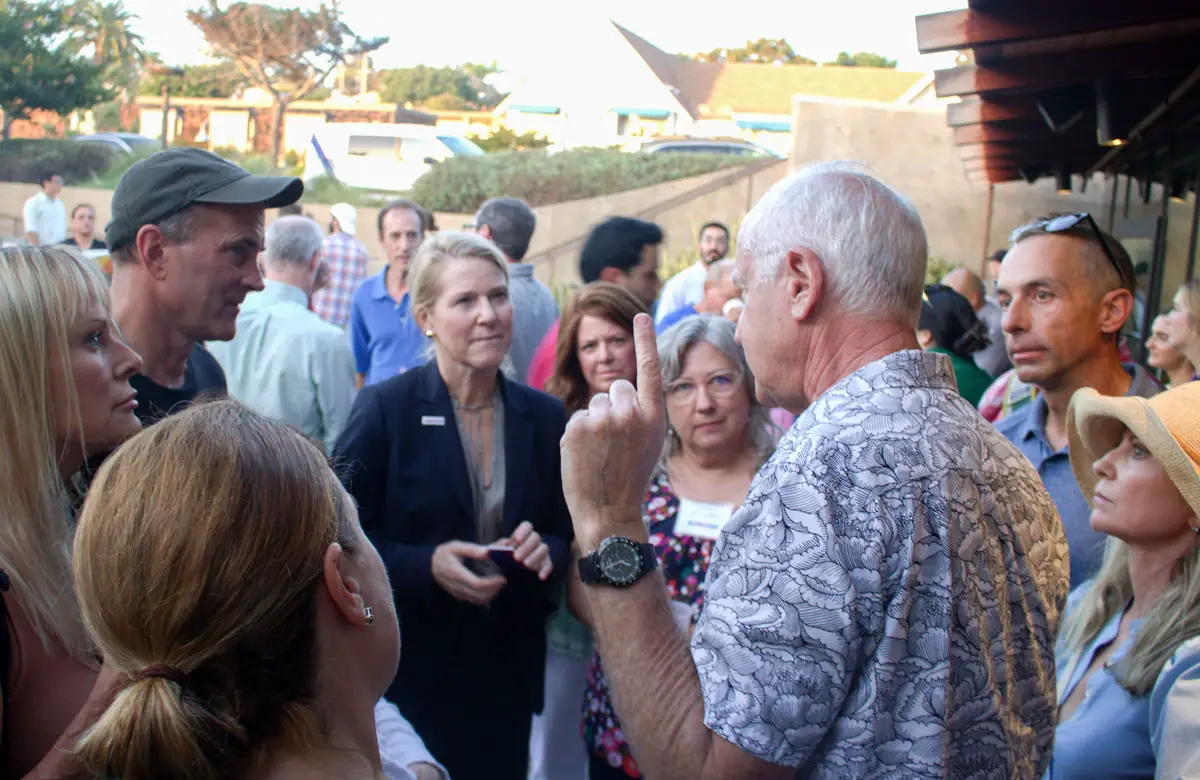DEL MAR — Leaders with the San Diego Association of Governments continued their outreach regarding the impending Del Mar railway realignment this past week, with the first in a series of public workshops.
The open house on Aug. 30 drew hundreds to the Del Mar Civic Center, where dozens of SANDAG representatives, including engineers and project designers, were present to share information and answer questions about current project plans.
By 2035, the agency aims to move a crucial 1.7-mile section of the Los Angeles-San Luis Obispo-San Diego, or LOSSAN, Rail Corridor off the failing Del Mar bluffs and into tunnels under the city.
The gargantuan effort comes with a multibillion-dollar price tag yet to be funded by the federal government.
SANDAG is still analyzing a series of alignment alternatives, two of which have been advanced for further study — a route along Camino Del Mar around 1,000 feet east of the current tracks and a high-speed option along Crest Canyon around 2,000 feet east.

While these two routes have been identified as the agency’s preferred alignments, leaders continue to emphasize that no final decision has been made.
“We’re gonna do the more detailed environmental analysis and technical studies that will help inform the actual chosen alignment that will go forward,” said SANDAG Deputy CEO Coleen Clementson.
Del Mar residents at the workshop had mixed feelings about the realignment, with many wanting to know how the city and their private property might be impacted — questions SANDAG said they cannot answer right now.
While feedback was encouraged, some residents said they did not feel confident that the agency would listen, particularly regarding which alignments they think are best.
“It seemed like there were a lot of proposals floating around, so it was hard to know what’s really going on. It’s hard to know if they’re really listening to us,” said Jennifer Sandler, who has lived in Del Mar for four years. “It’s a lot of sophisticated details to try to grasp, and it’s hard to know what makes sense for the majority of the people.”
Others said they were eager to see the train move off the bluff immediately.
“We’re spending so much time and money talking about it,” said Bobbie Ball, a Del Mar resident of nearly 40 years.

At a Del Mar City Council meeting in late July, residents expressed frustration that the agency had not been transparent in their communication or selection of which alignments to proceed with.
Two days after the workshop, on Sept. 1, SANDAG released a report detailing preliminary plans for various rail alternatives, including more in-depth design details for the Camino Del Mar and Crest Canyon high-speed options.
Alignment options
According to the report, the Camino Del Mar option would have the cheapest capital costs at $2.39 billion. The route would split off from the current rail right-of-way and cross Jimmy Durante Boulevard around 1,600 feet south of the San Dieguito Bridge, entering a 1.8-mile tunnel with a depth of up to 130 feet.
After continuing south and slightly southwest, the rail would exit the tunnel under Carmel Valley Road and cross a bridge across the Los Peñasquitos Lagoon. The alignment would continue south on two single-track bridge structures over McGonigle Road before rejoining the existing railway.
The Canyon Crest alignment has the second-lowest cost at $2.52 billion. The tunnel would begin around the same place as the Camino Del Mar alignment but extend 2.6 miles to the southeast, at depths up to 290 feet.
The tunnel would transition to a bridge section above Carmel Valley Road east of the Los Peñasquitos Lagoon and west of Interstate 5, eventually joining a bridge near Carmel Mountain Road.
Both alternatives could impact commercial and residential properties near the north tunnel portal, with the possibility of subsurface easements being required for tunnel segments under residences, the report stated.


The Crest Canyon option’s south portal could be located on an undeveloped parcel owned by an adjacent homeowner’s association. For the Camino Del Mar option, the south portal could potentially impact private residential property adjacent to the Torrey Pines State Reserve.
Other options include a route along I-5, and two additional routes along Crest Canyon — one with a more significant bridge segment to the south and another with a tunnel continuing beneath Carmel Valley Road.
While several residents have preferred the I-5 option, SANDAG explained in the report that this alignment would be the most expensive at just over $3 billion while offering the lowest rail speeds. Tunneling beneath the highway would also require a CalTrans permit, which may not be granted or could lead to construction delays.
SANDAG officials also said in a July presentation to the Del Mar City Council that the I-5 alignment would likely require the most property acquisition, as it involves an elevated railway over the Fairgrounds and San Dieguito Lagoon.
Further details about each alignment option, including the pros and cons for each, are available in the 148-page report.


Next steps
From now on, SANDAG is planning additional outreach and public feedback opportunities while continuing with rail realignment plans.
Before advancing any alignments into preliminary engineering phases, SANDAG said they would continue analyzing locations for tunnel portals and refining other details, including geologic subsurface conditions along the proposed routes, mitigation measures for potential impacts on private property, and habitat assessments.
The following additional workshops have also been scheduled in Del Mar:
Tunneling Workshop at Del Mar Civic Center
Oct. 4 — 6 to 7:30 p.m.
Virtual Open House via Zoom
Oct. 19 — 6 to 7:30 p.m.
Alignments Workshop at Del Mar Civic Center
Nov. 6 — 6 to 7:30 p.m.
Residents are also encouraged to share feedback via email at [email protected] and a hotline at 858-549-RAIL. People can also subscribe to the LOSSAN Corridor email list at SANDAG.org/subscribe.




